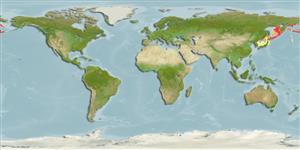Common names from other countries
Elasmobranchii (tubarões e raias) (sharks and rays) >
Rajiformes (Skates and rays) >
Arhynchobatidae (Softnose skates)
Etymology: Bathyraja: Greek, bathys = deep + Latin, raja, -ae = a ray (Raja sp) (Ref. 45335); minispinosa: Name from the Latin adjective 'minispinosa' meaning full of small thorns; referring to the dorsal side of the disc with many minute fine prickles which are smooth to the touch (Ref. 75535).
Environment: milieu / climate zone / depth range / distribution range
Ecologia
marinhas demersal; intervalo de profundidade 150 - 1420 m (Ref. 50550). Temperate
North Pacific: Sea of Okhotsk off Abashiri, Japan to the Kamchatka Peninsula and the Bering Sea.
Tamanho / Peso / Idade
Maturity: Lm ? range ? - ? cm
Max length : 82.5 cm TL macho/indeterminado; (Ref. 96339)
Descrição suscinta
Chaves de identificação | Morfologia | Morfometria
This species is distinguished from its congeners in Bathyraja in having a whitish area along the inner margin of eyes; dorsal side of disc with minute fine prickles; pointed clasper with a pseudosiphon-like groove; dense, minute prickles covering smaller egg capsule (Ref. 75535).
Juveniles feed mainly on amphipods, adults feed on crabs and fish (Ref. 27640). Oviparous. Distinct pairing with embrace. Young may tend to follow large objects, such as their mother (Ref. 205). Eggs are oblong capsules with stiff pointed horns at the corners deposited in sandy or muddy flats (Ref. 205). Egg capsules are 7.6 cm long and 5.5 cm wide (Ref. 41249).
Ciclo de vida ou comportamento de acasalamento
Maturities | Reprodução | Spawnings | Egg(s) | Fecundities | Larvas
Oviparous, paired eggs are laid. Embryos feed solely on yolk (Ref. 50449). Distinct pairing with embrace. Young may tend to follow large objects, such as their mother (Ref. 205). Eggs have horn-like projections on the shell (Ref. 205).
McEachran, J.D. and K.A. Dunn, 1998. Phylogenetic analysis of skates, a morphologically conservative clade of elasmobranchs (Chondrichthyes: Rajidae). Copeia 1998(2):271-290. (Ref. 27314)
Status na Lista Vermelha da UICN (Ref. 130435)
CITES (Ref. 128078)
Not Evaluated
Ameaça para os humanos
Harmless
Uso pelos humanos
Ferramentas
Relatórios especiais
Baixar XML
Fontes da internet
Estimates based on models
Preferred temperature (Ref.
115969): 0.8 - 3.6, mean 1.8 (based on 126 cells).
Índice de diversidade filogenética (Ref.
82804): PD
50 = 0.5000 [Uniqueness, from 0.5 = low to 2.0 = high].
Bayesian length-weight: a=0.00468 (0.00303 - 0.00721), b=3.05 (2.92 - 3.18), in cm Total Length, based on LWR estimates for this species & Genus-body shape (Ref.
93245).
Nível Trófico (Ref.
69278): 3.8 ±0.66 se; based on food items.
Resiliência (Ref.
120179): Baixo, tempo mínimo de duplicação da população 4,5 - 14 anos (Fec assumed to be <100).
Fishing Vulnerability (Ref.
59153): Moderate to high vulnerability (53 of 100).
